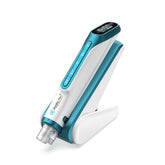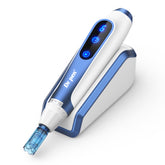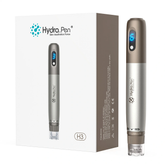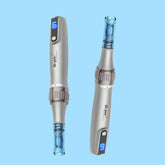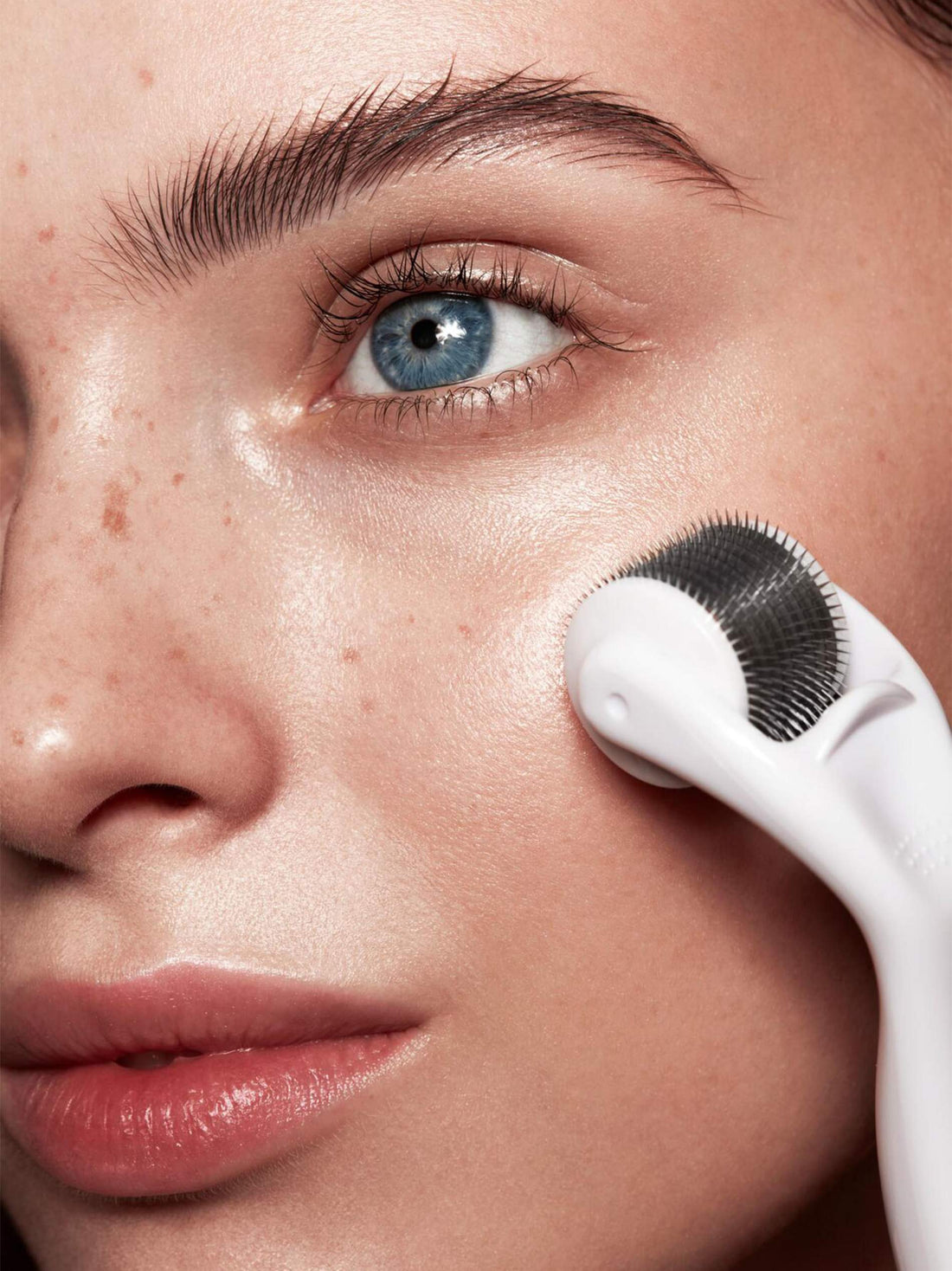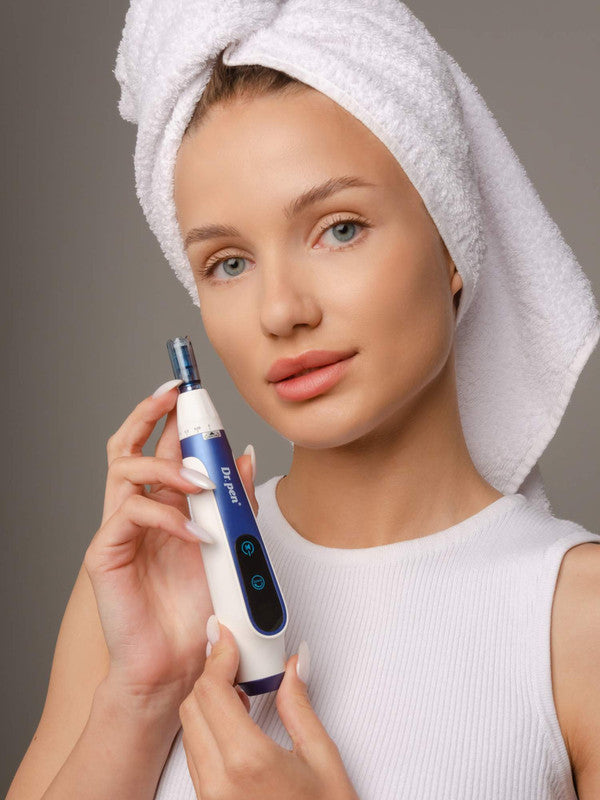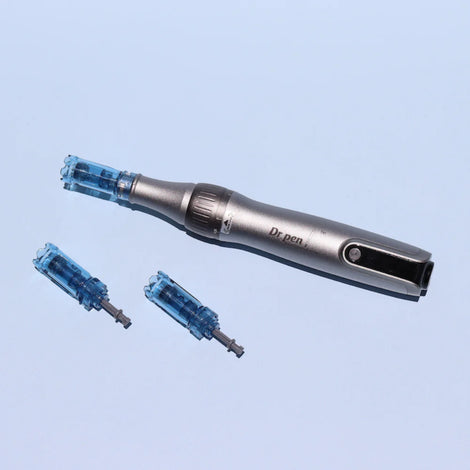What is microneedling?
First of all, it’s important to understand the difference between professional microneedling and at-home microneedling. In both cases, it’s a process in which a device containing ultra-fine needles is used to create tiny punctures in the skin. Sound scary? It’s not – when performed by a professional, it’s all about creating a controlled skin injury, which in turn causes the skin to work harder to heal itself. As dermatologist Dendy Engelman explains, “The slight injury stimulates the growth of collagen [the scaffolding under the skin], which then improves the appearance of some scars and wrinkles.” At home, it’s an even less invasive procedure. A microneedling tool such as a derma-stamp or derma-roller creates tiny ‘microchannels’ in the skin using much smaller needles than those used in a clinic. “The purpose of at-home microneedling is to help active ingredients penetrate deeper into the skin, resulting in better product efficacy,” Engelman continues. In short, it’s about ensuring your skincare works as hard as possible.
Is microneedling suitable for all skin types?
Those looking to tackle signs of aging or boost glow are most likely to see benefits from microneedling, while those experiencing active acne or rosacea should steer clear altogether – the device might spread bacteria around the face or worsen inflammation. It’s also crucial to use the right equipment. Make sure you’re buying a device designed for at-home use, with needles no longer than 0.25mm. And follow the instructions; don’t be tempted to use it more often than advised. Super-facialist Teresa Tarmey’s Microneedling Kit is designed to be used once weekly for 12 consecutive weeks, no more than twice a year. “I’m a big believer in little and often being far more effective than doing one or two strong clinic treatments,” she says. “Only using 0.25mm needles and following the program means it’ll never draw blood or hurt.”
How do you do microneedling at home?
Make sure the microneedling tool is thoroughly sterilized before you use it, and skin is cleansed. Apply your chosen serum before use, then apply the derma-roller or derma-stamp with gentle and even pressure. “Go over the area in an asterisk motion: up and down, diagonally left up to right, and diagonally right up to left,” advises Engelman. Afterwards, massage any leftover product into the skin, and avoid makeup for 24 hours if you can. The ideal time to do microneedling is before bed, so that actives can be allowed to penetrate while you sleep. But the key thing is to not overdo it; more is not always best, as you will keep creating inflammation. Stick to no more than twice a week.
Which skincare products should you use?
“Facial serums will be most effective in delivering to the cellular level, as they have the highest concentration of active ingredients and have smaller molecules that allow actives to penetrate further,” says Engelman. Consider hyaluronic acid, niacinamide and peptides, but steer clear of retinol and vitamin C for a couple of days while the skin heals, as they might cause irritation. iS Clinical’s kit features a peptide blend for use during the treatment itself, and then she recommends following up with products known for soothing and moisturizing. “You can get dryness in the rejuvenation process, so focus on hydrating products,” she explains. Spending 10 to 15 minutes with a hydrating, hyaluronic acid-based mask after microneedling is a great way to calm skin while boosting moisture.
What results can you expect?
If you’re already using good products, microneedling is a great way to get the most out of them, whether it’s for tackling fine lines, boosting hydration or improving tone. All the benefits you already expect from your skincare, just multiplied. And on top of that, some serious glow.
What’s next?
Microneedling is now being used as a scalp treatment to help improve the quality of new hair and minimize thinning. Just like the skin on your face, the scalp, too, loses collagen as the years go by, which can have an impact on hair follicles. This means they can become lazy, producing sub-par hair, or even fall dormant. Dermatologists and trichologists are using microneedling treatments to stimulate the scalp to produce more collagen and boost blood flow, thus improving the quality and quantity of hair. It’s far from a quick fix, but when used alongside a more comprehensive regimen or treatments – such as topical and low-energy light or laser treatments – it can have a real long-term benefit.
The best serums to use after microneedling
One of the biggest purported benefits of microneedling is its ability to help products like serums and moisturizers penetrate deeper and become more effective.
“[Needling improves serum] absorption into the deeper layers,” Welsh says. Skin penetrability is a good thing if you’re introducing skin-healthy ingredients, but it also means you have to be extra careful about the products you use.
“One of the biggest issues with microneedling is not introducing topicals or chemicals that should not penetrate past our epidermis deeper into our skin.”
Here are ingredients to look for in your serums:
Vitamin C: Finding a high-quality serum to brighten and promote collagen is of the utmost importance. “There are case reports of granulomas (firm nodules) from people applying topicals such as vitamin C which contain ingredients in the formulation which induce a foreign body reaction in the skin,” “Also, sterility of the needles is paramount to prevent infection.”
Hyaluronic acid: Hyaluronic acid attracts and retains moisture, so applying it after microneedling can help plump and hydrate the skin.
Peptides: Copper peptides are naturally-occurring complexes in the skin that, when applied topically, have been found to increase the production of collagen.
Growth factors: Growth factors are proteins that promote the production of healthy cells and tissues. They bind to your skin cells and signal to repair and rejuvenate your skin. For microneedling, they act hand-in-hand with thickening skin.
How often should you do at-home microneedling?
The frequency of your treatments will depend on the length of your derma roller’s needles and your skin’s sensitivity. If your needles are shorter, you may be able to roll every other day, and if the needles are much longer, you may need to space out treatments every three to four weeks.
If you’re really looking to rev up your results, you may want to consider adding in additional skin care treatments between your microneedling sessions.
According to Dermascope, a professional skin care journal, microneedling and chemical peels produce better results as complementary treatments when administered 4 to 6 weeks apart.
If your skin tolerates it, other treatments like gua sha and facial acupuncture may accelerate your results when interspersed with microneedling as well.
First of all, it’s important to understand the difference between professional microneedling and at-home microneedling. In both cases, it’s a process in which a device containing ultra-fine needles is used to create tiny punctures in the skin. Sound scary? It’s not – when performed by a professional, it’s all about creating a controlled skin injury, which in turn causes the skin to work harder to heal itself. As dermatologist Dendy Engelman explains, “The slight injury stimulates the growth of collagen [the scaffolding under the skin], which then improves the appearance of some scars and wrinkles.” At home, it’s an even less invasive procedure. A microneedling tool such as a derma-stamp or derma-roller creates tiny ‘microchannels’ in the skin using much smaller needles than those used in a clinic. “The purpose of at-home microneedling is to help active ingredients penetrate deeper into the skin, resulting in better product efficacy,” Engelman continues. In short, it’s about ensuring your skincare works as hard as possible.
Is microneedling suitable for all skin types?
Those looking to tackle signs of aging or boost glow are most likely to see benefits from microneedling, while those experiencing active acne or rosacea should steer clear altogether – the device might spread bacteria around the face or worsen inflammation. It’s also crucial to use the right equipment. Make sure you’re buying a device designed for at-home use, with needles no longer than 0.25mm. And follow the instructions; don’t be tempted to use it more often than advised. Super-facialist Teresa Tarmey’s Microneedling Kit is designed to be used once weekly for 12 consecutive weeks, no more than twice a year. “I’m a big believer in little and often being far more effective than doing one or two strong clinic treatments,” she says. “Only using 0.25mm needles and following the program means it’ll never draw blood or hurt.”
How do you do microneedling at home?
Make sure the microneedling tool is thoroughly sterilized before you use it, and skin is cleansed. Apply your chosen serum before use, then apply the derma-roller or derma-stamp with gentle and even pressure. “Go over the area in an asterisk motion: up and down, diagonally left up to right, and diagonally right up to left,” advises Engelman. Afterwards, massage any leftover product into the skin, and avoid makeup for 24 hours if you can. The ideal time to do microneedling is before bed, so that actives can be allowed to penetrate while you sleep. But the key thing is to not overdo it; more is not always best, as you will keep creating inflammation. Stick to no more than twice a week.
Which skincare products should you use?
“Facial serums will be most effective in delivering to the cellular level, as they have the highest concentration of active ingredients and have smaller molecules that allow actives to penetrate further,” says Engelman. Consider hyaluronic acid, niacinamide and peptides, but steer clear of retinol and vitamin C for a couple of days while the skin heals, as they might cause irritation. iS Clinical’s kit features a peptide blend for use during the treatment itself, and then she recommends following up with products known for soothing and moisturizing. “You can get dryness in the rejuvenation process, so focus on hydrating products,” she explains. Spending 10 to 15 minutes with a hydrating, hyaluronic acid-based mask after microneedling is a great way to calm skin while boosting moisture.
What results can you expect?
If you’re already using good products, microneedling is a great way to get the most out of them, whether it’s for tackling fine lines, boosting hydration or improving tone. All the benefits you already expect from your skincare, just multiplied. And on top of that, some serious glow.
What’s next?
Microneedling is now being used as a scalp treatment to help improve the quality of new hair and minimize thinning. Just like the skin on your face, the scalp, too, loses collagen as the years go by, which can have an impact on hair follicles. This means they can become lazy, producing sub-par hair, or even fall dormant. Dermatologists and trichologists are using microneedling treatments to stimulate the scalp to produce more collagen and boost blood flow, thus improving the quality and quantity of hair. It’s far from a quick fix, but when used alongside a more comprehensive regimen or treatments – such as topical and low-energy light or laser treatments – it can have a real long-term benefit.
The best serums to use after microneedling
One of the biggest purported benefits of microneedling is its ability to help products like serums and moisturizers penetrate deeper and become more effective.
“[Needling improves serum] absorption into the deeper layers,” Welsh says. Skin penetrability is a good thing if you’re introducing skin-healthy ingredients, but it also means you have to be extra careful about the products you use.
“One of the biggest issues with microneedling is not introducing topicals or chemicals that should not penetrate past our epidermis deeper into our skin.”
Here are ingredients to look for in your serums:
Vitamin C: Finding a high-quality serum to brighten and promote collagen is of the utmost importance. “There are case reports of granulomas (firm nodules) from people applying topicals such as vitamin C which contain ingredients in the formulation which induce a foreign body reaction in the skin,” “Also, sterility of the needles is paramount to prevent infection.”
Hyaluronic acid: Hyaluronic acid attracts and retains moisture, so applying it after microneedling can help plump and hydrate the skin.
Peptides: Copper peptides are naturally-occurring complexes in the skin that, when applied topically, have been found to increase the production of collagen.
Growth factors: Growth factors are proteins that promote the production of healthy cells and tissues. They bind to your skin cells and signal to repair and rejuvenate your skin. For microneedling, they act hand-in-hand with thickening skin.
How often should you do at-home microneedling?
The frequency of your treatments will depend on the length of your derma roller’s needles and your skin’s sensitivity. If your needles are shorter, you may be able to roll every other day, and if the needles are much longer, you may need to space out treatments every three to four weeks.
If you’re really looking to rev up your results, you may want to consider adding in additional skin care treatments between your microneedling sessions.
According to Dermascope, a professional skin care journal, microneedling and chemical peels produce better results as complementary treatments when administered 4 to 6 weeks apart.
If your skin tolerates it, other treatments like gua sha and facial acupuncture may accelerate your results when interspersed with microneedling as well.




